Investigation of a Circularly Polarized Metasurface Antenna for Hybrid Wireless Applications
Abstract
:1. Introduction
2. Antenna Design
3. CP Mechanism: CEM Approach
4. AI-Tuned Design and Implementation of Metasurface (RMS)
5. CP Mechanism: GBR Approach
6. Measurement
7. RF Energy Harvesting: Simulation Perspective from IoT Application
8. Implementation Perspective: A Quick Overview
- This simple antenna employs the monopole and parasitic conducting strip configurations. Because the polarization pattern is meant to look like a CP, there is no need for electromagnetic circuits for it to work well.
- The incorporation of an RF PIN Diode (BAR 50-02V from Infineon Technologies) in a unique manner avoids using additional lumped parts due to planar configuration and less complex antenna design to attain polarization reconfigurability (i.e., LP to CP).
- CP is examined using a novel gain-bandwidth product. Also, four methodologies are shown to highlight the significance of CP feature analysis at the operating bandwidth.
- With the addition of a SADEA-driven metasurface (RMS) reflector in a single layer, there is a significant improvement in impedance and axial ratio bandwidth responses (broadband characteristics). An enhanced CP antenna accompanies this improvement gain > 8.45 dBic, which provides a superior performance in comparison to [10,11,12,13,14,15,16,17,18,19,20,21,22,23,24,25,26,27,28,29], from the perspective of IoT-inspired RF energy harvesting, aiming towards energy-efficient communication and computing technologies.
- Here, the ∘ and Vout are computed by ADS. The proposed SADEA-driven metasurface antenna is tested with the CRLH- and LC-based Grienacher voltage doubler circuits (GVD). The antenna system has CRLH- and LC-based Grienacher voltage doubler circuits (GVD) built into it so that the potential utility of the system can be tested out in relation to an application that uses RF energy harvesting, which presents a more effective method towards implementing rectifiers than those stated in [46,47,48,49,50,51]. Also, in this case, the maximum Vout that can be attained is 5.39 V (for I) and 5.44 V (for II), and the maximum ∘ that can be attained is 56.28% (for I) and 73.82% (for II), respectively. A comparative study in this regard is already given in Table 2.
9. AI-Enabled IoT Applications towards Smart Living: A Future Research Direction
10. Conclusions
Author Contributions
Funding
Institutional Review Board Statement
Informed Consent Statement
Data Availability Statement
Conflicts of Interest
References
- Divakaran, S.K.; Krishna, D.D.; Nasimuddin, N. RF energy harvesting systems: An overview and design issues. Int. J. Microw.-Comput.-Aided Eng. 2019, 29, e21633. [Google Scholar] [CrossRef]
- Behera, B.R.; Meher, P.R.; Mishra, S.K. Microwave antennas-An intrinsic part of RF energy harvesting systems: A contingent study about design methodologies and state-of-the-art technologies in current scenario. Int. J. Microw.-Comput.-Aided Eng. 2020, 30, e22148. [Google Scholar] [CrossRef]
- Toh, B.Y.; Cahill, R.; Fusco, V.F. Understanding and measuring circular polarization. IEEE Trans. Educ. 2003, 46, 313–318. [Google Scholar]
- Sahu, N.K.; Mishra, S.K. Compact dual-band dual-polarized monopole antennas using via-free metasurfaces for off-body communications. IEEE Antennas Wirel. Propag. Lett. 2022, 21, 1358–1362. [Google Scholar] [CrossRef]
- Mouapi, A. Radiofrequency energy harvesting systems for internet of things applications: A comprehensive overview of design issues. Sensors 2022, 22, 8088. [Google Scholar] [CrossRef] [PubMed]
- Behera, B.R.; Meher, P.R.; Mishra, S.K. Metasurface superstrate inspired printed monopole antenna for RF energy harvesting application. Prog. Electromagn. Res. C 2021, 110, 119–133. [Google Scholar] [CrossRef]
- Milias, C.; Muhammad, B.; Kristensen, J.T.B.; Mihovska, A.; Hermansen, D.D.S. Metamaterial-inspired antennas: A review of the state of the art and future design challenges. IEEE Access 2021, 9, 89846–89865. [Google Scholar] [CrossRef]
- Iqbal, K.; Khan, Q.U. Review of metasurfaces through unit cell design and numerical extraction of parameters and their applications in antennas. IEEE Access 2022, 10, 112368–112391. [Google Scholar] [CrossRef]
- Esmail, B.A.F.; Koziel, S.; Szczepanski, S. Overview of planar antenna loading metamaterials for gain performance enhancement: The two decades of progress. IEEE Access 2022, 10, 27381–27403. [Google Scholar] [CrossRef]
- Elahi, M.; Altaf, A.; Yang, Y.; Lee, K.Y.; Hwang, K.C. Circularly polarized dielectric resonator antenna with two annular vias. IEEE Access 2021, 21, 41123–41128. [Google Scholar] [CrossRef]
- Lin, W.; Wong, H. Polarization reconfigurable wheel-shaped antenna with conical-beam radiation pattern. IEEE Trans. Antennas Propag. 2015, 63, 491–499. [Google Scholar] [CrossRef]
- Lin, W.; Wong, H. Wideband circular-polarization reconfigurable antenna with L-shaped feeding probes. IEEE Antennas Wirel. Propag. Lett. 2017, 16, 2114–2117. [Google Scholar] [CrossRef]
- Chen, Z.; Wong, H. Liquid dielectric resonator antenna with circular polarization reconfigurability. IEEE Trans. Antennas Propag. 2018, 66, 444–449. [Google Scholar] [CrossRef]
- Yang, W.W.; Dong, X.Y.; Sun, W.J.; Chen, J.X. Polarization reconfigurable broadband dielectric resonator antenna with a lattice structure. IEEE Access 2018, 6, 21212–21219. [Google Scholar] [CrossRef]
- Wang, S.; Yang, D.; Geyi, W.; Zhao, C.; Ding, G. Polarization-reconfigurable antenna using combination of circular polarized modes. IEEE Access 2021, 9, 45622–45631. [Google Scholar] [CrossRef]
- Zhu, H.L.; Cheung, S.W.; Liu, X.H.; Yuk, T.I. Design of polarization reconfigurable antenna using metasurface. IEEE Trans. Antennas Propag. 2014, 62, 2891–2898. [Google Scholar] [CrossRef]
- Yang, W.; Che, W.; Jin, H.; Feng, W.; Xue, Q. A polarization-reconfigurable dipole antenna using polarization rotation AMC structure. IEEE Trans. Antennas Propag. 2015, 63, 5305–5315. [Google Scholar] [CrossRef]
- Wu, Z.; Li, L.; Li, Y.; Chen, X. Metasurface superstrate antenna with wideband circular polarization for satellite communication application. IEEE Antennas Wirel. Propag. Lett. 2016, 15, 374–377. [Google Scholar] [CrossRef]
- Wu, F.; Luk, K. Single-port reconfigurable magneto-electric dipole antenna with quad-polarization diversity. IEEE Trans. Antennas Propag. 2017, 65, 2289–2296. [Google Scholar] [CrossRef]
- Lin, W.; Wong, H.; Ziolkowski, R.W. Circularly polarized antenna with reconfigurable broadside and conical beams facilitated by a mode switchable feed network. IEEE Trans. Antennas Propag. 2018, 66, 996–1001. [Google Scholar] [CrossRef]
- Lin, W.; Chen, S.L.; Ziolkowski, R.W.; Guo, Y.J. Reconfigurable, wideband, low-profile, circularly polarized antenna & array enabled by an artificial magnetic conductor ground. IEEE Trans. Antennas Propag. 2018, 66, 1564–1569. [Google Scholar]
- Chen, X.; Zhao, Y. Dual-band polarization and frequency reconfigurable antenna using double layer metasurface. AEUE-Int. J. Electron. Commun. 2018, 95, 82–87. [Google Scholar] [CrossRef]
- Zheng, Q.; Guo, C.; Ding, J. Wideband and low RCS circularly polarized slot antenna based on polarization conversion of metasurface for satellite communication application. Microw. Opt. Technol. Lett. 2018, 60, 679–685. [Google Scholar] [CrossRef]
- Tran, H.H.; Park, H.C. Wideband reconfigurable antenna with simple biasing circuit and tri-polarization diversity. IEEE Antennas Wirel. Propag. Lett. 2019, 18, 2001–2005. [Google Scholar] [CrossRef]
- Li, W.; Wang, Y.M.; Hei, Y.; Li, B.; Shi, X. A compact low-profile reconfigurable metasurface antenna with polarization and pattern diversities. IEEE Antennas Wirel. Propag. Lett. 2020, 7, 1170–1174. [Google Scholar] [CrossRef]
- Chen, A.; Ning, X. A pattern and polarization reconfigurable antenna with metasurface. Int. J. Microw.-Comput.-Aided Eng. 2021, 31, e22312. [Google Scholar] [CrossRef]
- Tran, H.H.; Bui, C.D.; Nguyen-Trong, N.; Nguyen, T.K. A wideband non-uniform metasurface-based circularly polarized reconfigurable antenna. IEEE Access 2021, 9, 42325–42332. [Google Scholar] [CrossRef]
- Li, W.; Xia, S.; He, B.; Chen, J.; Shi, H.; Zhang, A.; Li, Z.; Xu, Z. A reconfigurable polarization converter using active metasurface and its application in horn antenna. IEEE Trans. Antennas Propag. 2016, 64, 5281–5290. [Google Scholar] [CrossRef]
- Van Aardt, R.; Joubert, J.; Odendaal, J.W. A dipole with reflector-backed active metasurface for the linear-to-circular polarization reconfigurability. Materials 2022, 15, 3026. [Google Scholar] [CrossRef]
- Yao, L.; Lin, H.; Koshelev, K.; Zhang, F.; Yang, Y.; Wu, J.; Kivshar, Y.; Jia, B. Full-stokes polarization perfect absorption with diatomic metasurfaces. Nano Lett. 2021, 21, 1090–1095. [Google Scholar]
- Wilson, N.C.; Shin, E.; Bangle, R.E.; Nikodemski, S.B.; Vella, J.H.; Mikkelsen, M.H. Ultrathin pyroelectric photodetector with integrated polarization-sensing metasurface. Nano Lett. 2023, 23, 8547–8552. [Google Scholar] [CrossRef]
- Mohanty, A.; Behera, B.R.; Esselle, K.P.; Alsharif, M.H.; Jahid, A.; Mohsan, S.A.H. Investigation of a dual-layer metasurface-inspired fractal antenna with dual-polarized/-modes for 4G/5G applications. Electronics 2022, 11, 2371. [Google Scholar] [CrossRef]
- Meher, P.R.; Behera, B.R.; Mishra, S.K. A compact circularly polarized cubic DRA with unit-step feed for Bluetooth/ISM/Wi-Fi/Wi-MAX applications. AEUE-Int. J. Electron. Commun. 2021, 128, 153521. [Google Scholar] [CrossRef]
- Grout, V.; Akinsolu, M.O.; Liu, B.; Lazaridis, P.I.; Mistry, K.K.; Zaharis, Z.D. Software solutions for antenna design exploration: A comparison of packages, tools, techniques, and algorithms for various design challenges. IEEE Antennas Propag. Mag. 2019, 61, 48–59. [Google Scholar] [CrossRef]
- Liu, B.; Aliakbarian, H.; Ma, Z.; Vandenbosch, G.A.E.; Gielen, G.; Excell, P. An efficient method for antenna design optimization based on evolutionary computation and machine learning techniques. IEEE Trans. Antennas Propag. 2014, 62, 7–18. [Google Scholar] [CrossRef]
- Liu, B.; Koziel, S.; Ali, N. SADEA-II: A generalized method for efficient global optimization of antenna design. J. Comput. Des. Eng. 2017, 4, 86–97. [Google Scholar] [CrossRef]
- Liu, B.; Akinsolu, M.O.; Ali, N.; Abd-Alhameed, R. Efficient global optimisation of microwave antennas based on a parallel surrogate model-assisted evolutionary algorithm. IET Microwaves Antennas Propag. 2019, 13, 149–155. [Google Scholar] [CrossRef]
- Akinsolu, M.; Liu, B.; Grout, V.; Lazaridis, P.I.; Mognaschi, M.E.; Barba, P.D. A parallel surrogate model assisted evolutionary algorithm for electromagnetic design optimization. IEEE Trans. Emerg. Top. Comput. Intell. 2019, 3, 93–105. [Google Scholar] [CrossRef]
- Liu, B.; Akinsolu, M.O.; Song, C.; Hua, Q.; Excell, P.; Xu, Q.; Huang, Y.; Imran, M.A. An efficient method for complex antenna design based on a self adaptive surrogate model-assisted optimization technique. IEEE Trans. Antennas Propag. 2021, 69, 2302–2315. [Google Scholar] [CrossRef]
- Zhang, J.; Akinsolu, M.O.; Liu, B.; Vandenbosch, G.A.E. Automatic AI-driven design of the mutual coupling reducing topologies for the frequency reconfigurable antenna arrays. IEEE Trans. Antennas Propag. 2021, 69, 1831–1836. [Google Scholar] [CrossRef]
- Zheng, Q.; Guo, C.; Ding, J.; Akinsolu, M.O.; Liu, B.; Vandenbosch, G.A.E. A wideband low-RCS metasurface-inspired circularly polarized slot array based on the AI-driven antenna design optimization algorithm. IEEE Trans. Antennas Propag. 2022, 70, 8584–8589. [Google Scholar] [CrossRef]
- Mohanty, A.; Behera, B.R.; Nasimuddin, N. Hybrid metasurface loaded tri-port compact antenna with gain enhancement and pattern diversity. Int. J. Microw. Comput. Eng. 2021, 31, e22795. [Google Scholar] [CrossRef]
- Jhansi, Y.; Poojitha, P.; Mahigeethika, D.; Behera, B.R.; Pal, D. Investigation of a FSS inspired printed monopole antenna with gain enhancement for 5G applications. In Proceedings of the 2023 IEEE International Conference on Recent Advances in Electrical, Electronics, Ubiquitous Communication, and Computational Intelligence (RAEEUCCI), Chennai, India, 19–21 April 2023; pp. 1–4. [Google Scholar]
- Sneha, D.S.; Rajesh, M.; Sravani, V.; Behera, B.R.; Pal, D. Non-uniform metasurface-based microstrip patch antenna with bandwidth and gain enhancement for wireless applications. In Proceedings of the 2023 IEEE International Conference on Recent Advances in Electrical, Electronics, Ubiquitous Communication, and Computational Intelligence (RAEEUCCI), Chennai, India, 9–21 April 2023; pp. 1–4. [Google Scholar]
- Xu, K. Silicon electro-optic micro-modulator fabricated in standard CMOS technology as components for all silicon monolithic integrated optoelectronic systems. J. Micromech. Microeng. 2021, 21, 054001. [Google Scholar] [CrossRef]
- Jie, A.M.; Nasimuddin Karim, M.F.; Chandrasekaran, K.T. A wide-angle circularly polarized tapered-slit patch antenna with a compact rectifier for energy harvesting systems. IEEE Antennas Propag. Mag. 2019, 61, 94–111. [Google Scholar] [CrossRef]
- Bakkali, A.; Pelegri-Sebastia, J.; Sogorb, T.; Llario, V.; Bou-Escriva, A. A dual-band antenna for RF energy harvesting systems in wireless sensor networks. J. Sens. 2016, 5725836. [Google Scholar] [CrossRef]
- Singh, N.; Kanaujia, B.K.; Beg, M.T.; Khan, T.; Kumar, S. A dual polarized multiband rectenna for RF energy harvesting. AEUE-Int. J. Electron. Commun. 2018, 93, 123–131. [Google Scholar] [CrossRef]
- Surender, D.; Halimi, M.A.; Khan, T.; Talukdar, F.A.; Antar Yahia, M.M. Circularly polarized DRA rectenna for 5G and Wi-Fi bands RF energy harvesting in smart city applications. IETE Tech. Rev. 2022, 39, 880–893. [Google Scholar] [CrossRef]
- Dardeer, O.M.; Elsadek, H.A.; Abdallah, E.A.; Elhennawy, H.M. A dual band circularly polarized rectenna for RF energy harvesting applications. ACES J. 2019, 34, 1594–1600. [Google Scholar]
- Chandrasekaran, K.T.; Agarwal, K.; Alphones, A.; Mitra, R.; Karim, M.F. Compact dual-band metamaterial-based high-efficiency rectenna: An application for ambient electromagnetic energy harvesting. IEEE Antennas Propag. Mag. 2020, 62, 18–29. [Google Scholar] [CrossRef]
- Alsharif, M.H.; Kelechi, A.H.; Albreem, M.A.; Chaudhry, S.A.; Zia, M.S.; Kim, S. Sixth generation (6G) wireless networks: Vision, research activities, challenges and potential solutions. Symmetry 2020, 12, 676. [Google Scholar] [CrossRef]
- Arun Kumar, A.; Nanthaamornphong, A.; Selvi, R.; Venkatesh, J.; Alsharif, M.H.; Uthansakul, P.; Uthansakul, M. Evaluation of 5G techniques affecting the deployment of smart hospital infrastructure: Understanding 5G, AI and IoT role in smart hospital. Alex. Eng. J. 2023, 83, 335–354. [Google Scholar] [CrossRef]
- Behera, B.R.; Mishra, S.K. Investigation of a broadband circularly polarized printed monopole antenna for RF energy harvesting application. In Proceedings of the 2022 URSI Regional Conference on Radio Science (URSI-RCRS), Indore, India, 1–4 December 2022; pp. 1–4. [Google Scholar]
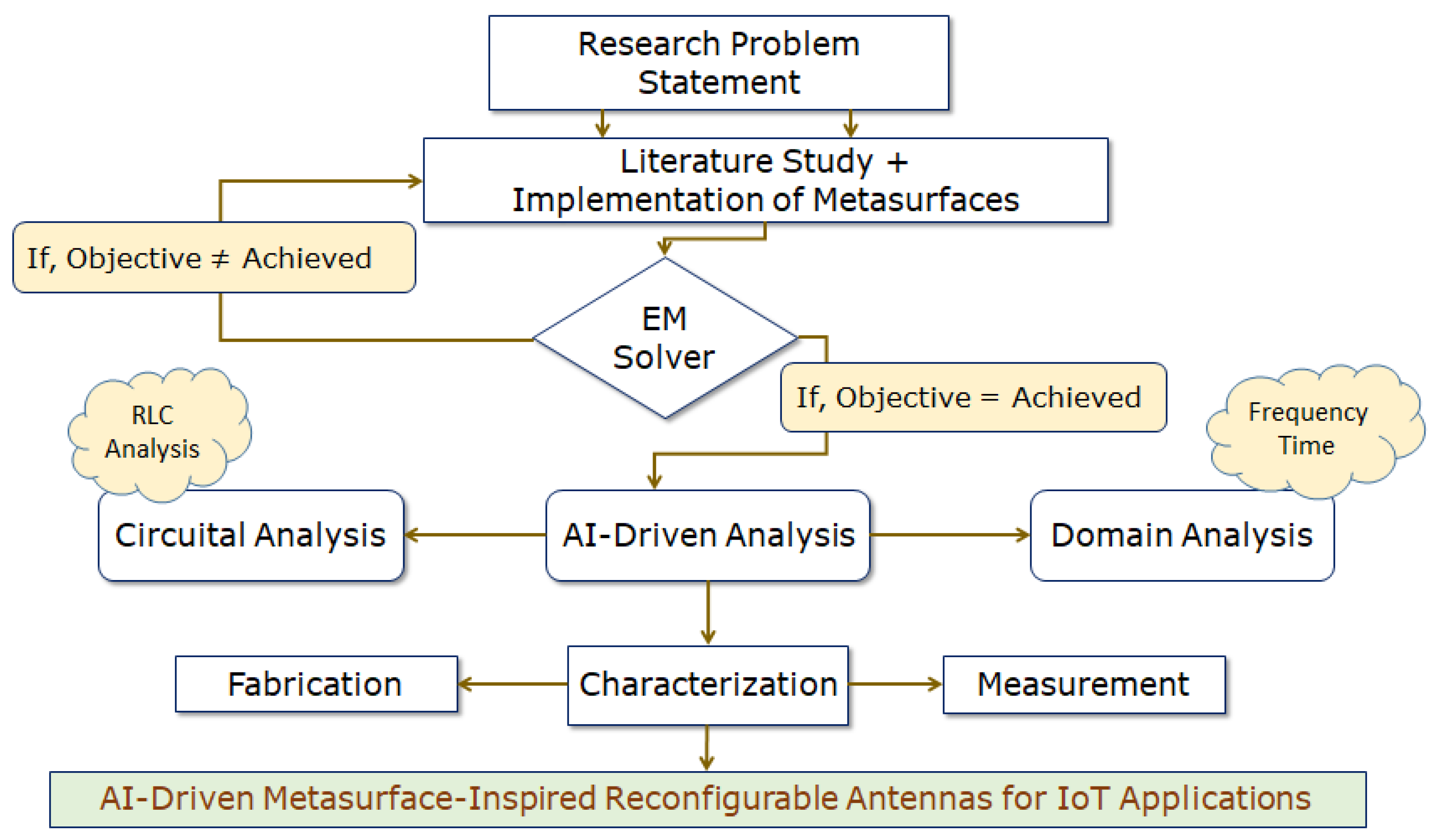
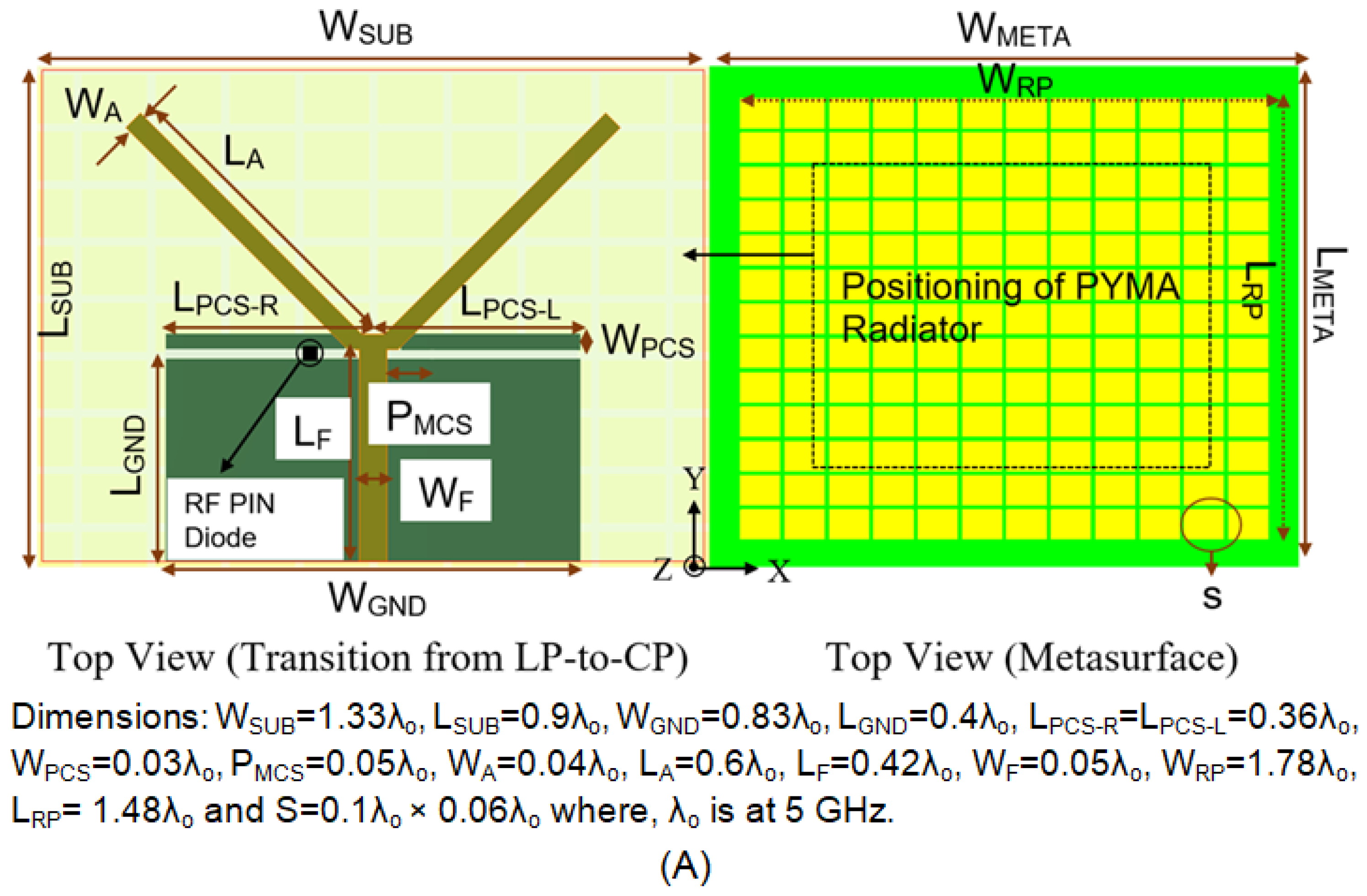
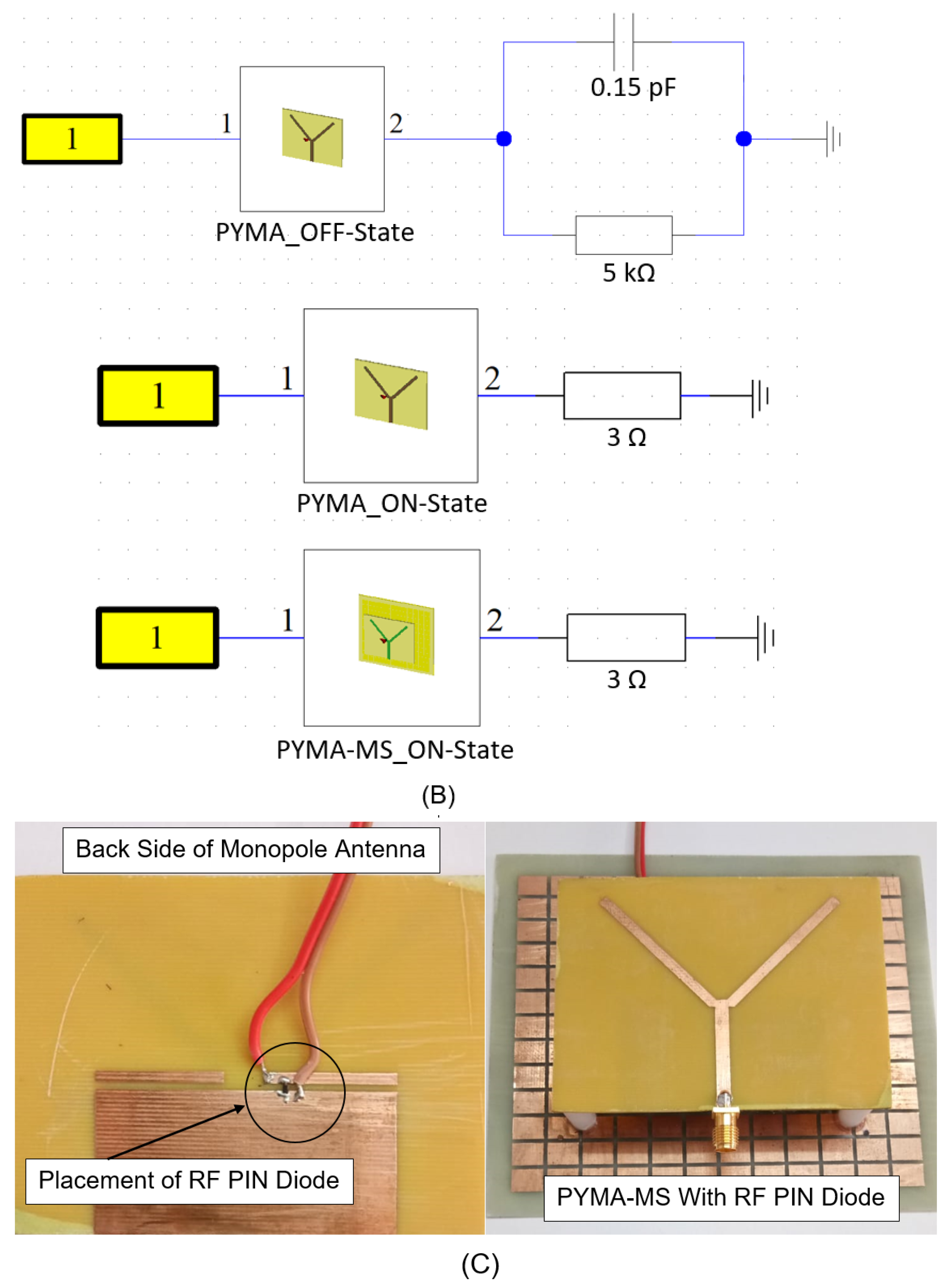
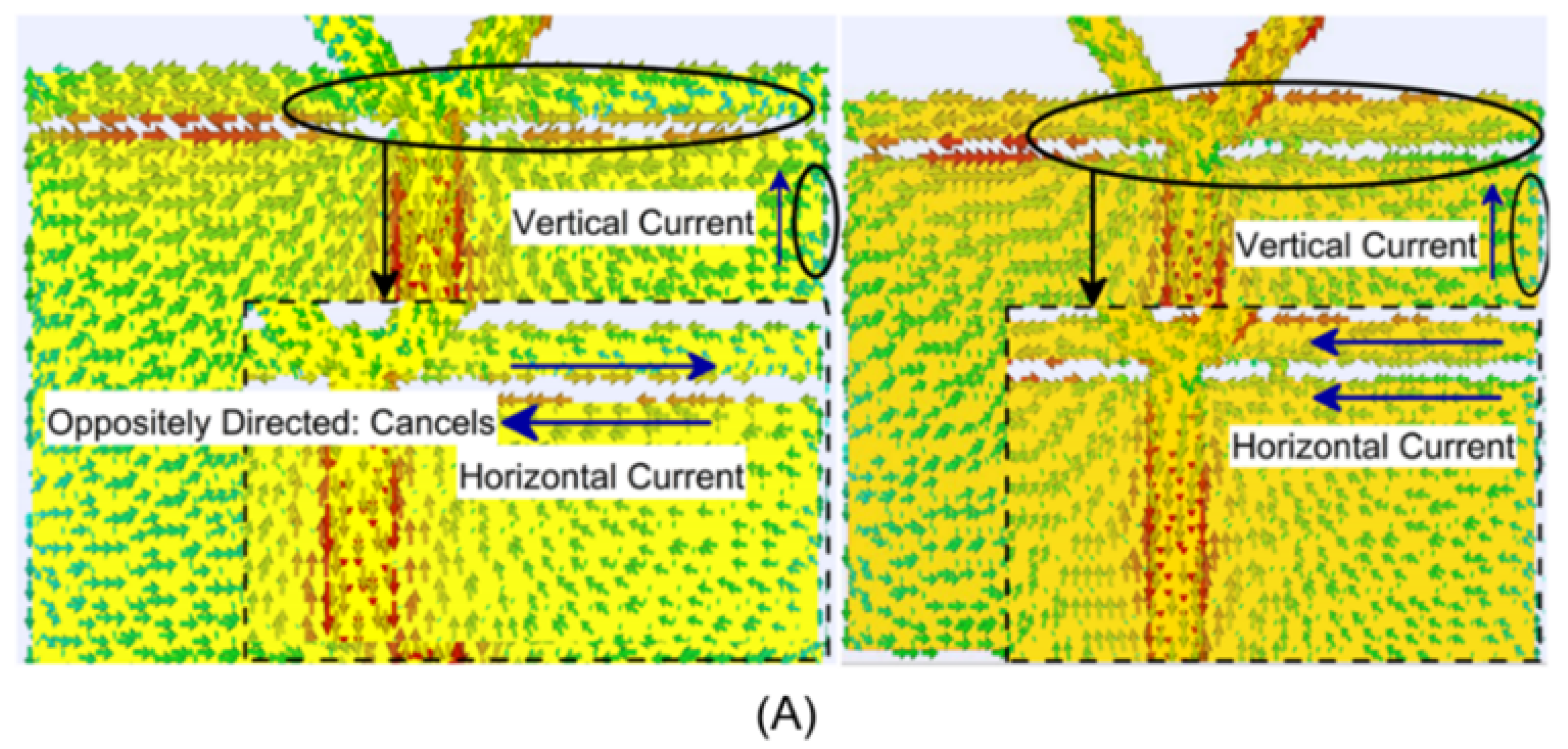

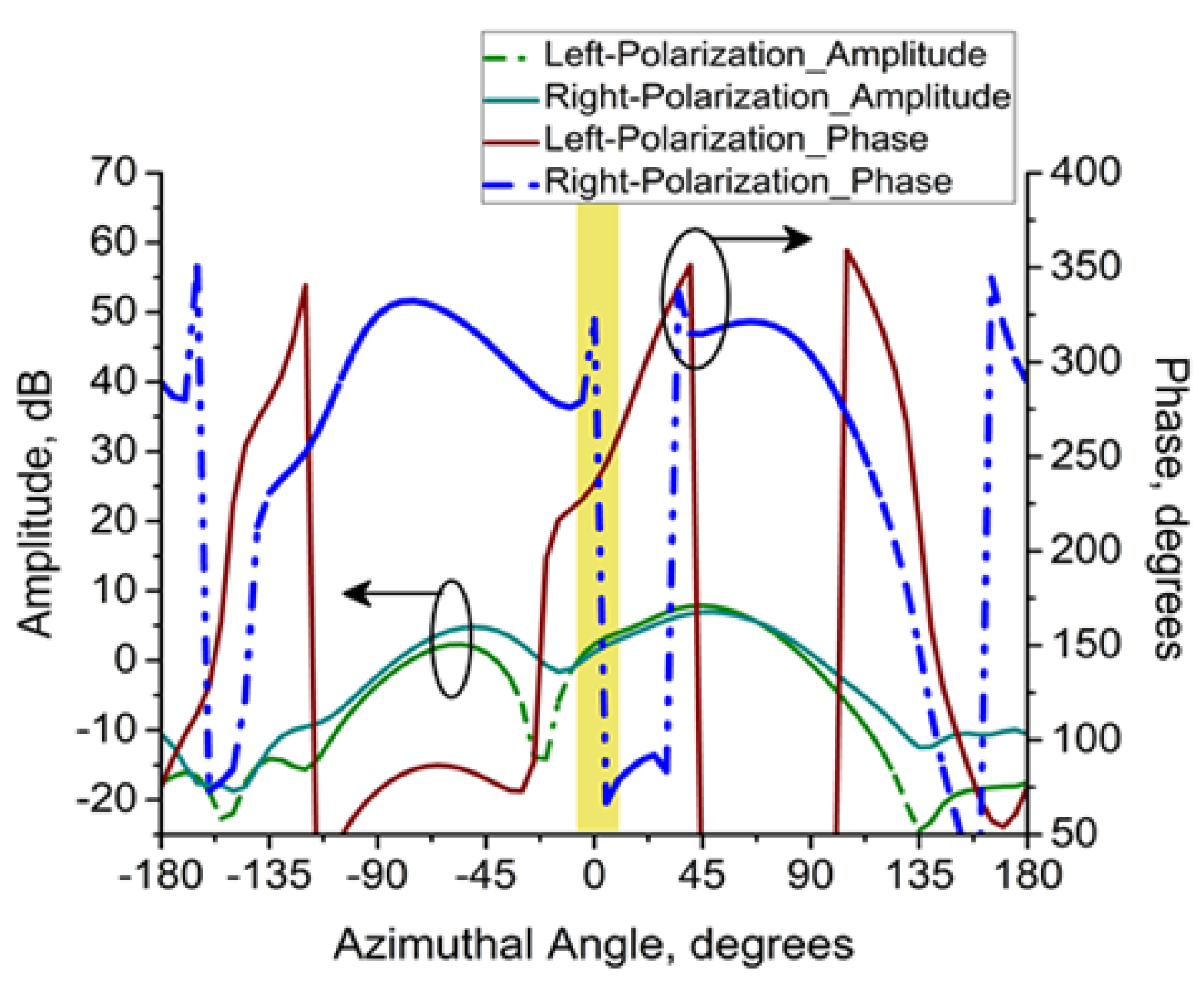

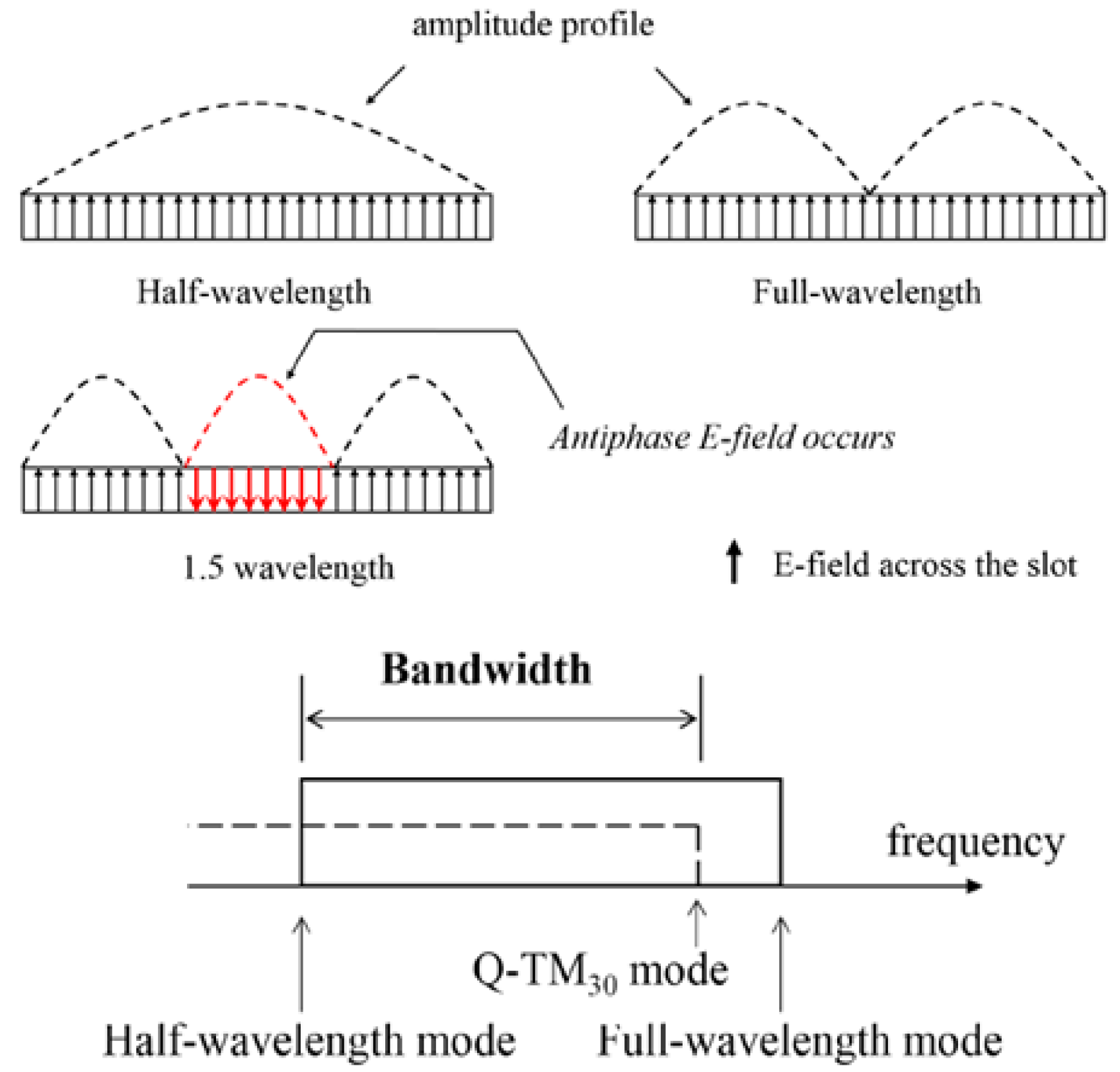
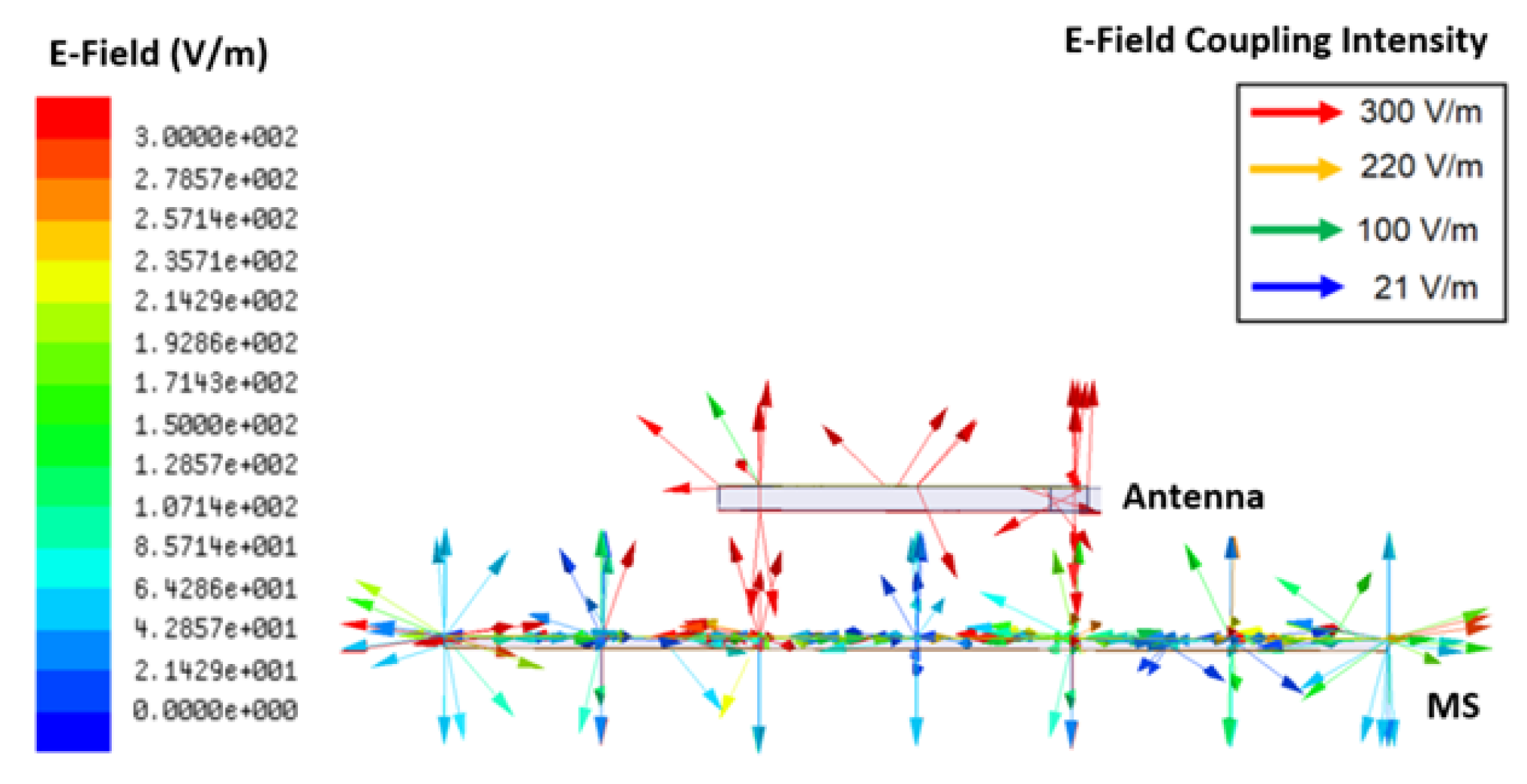

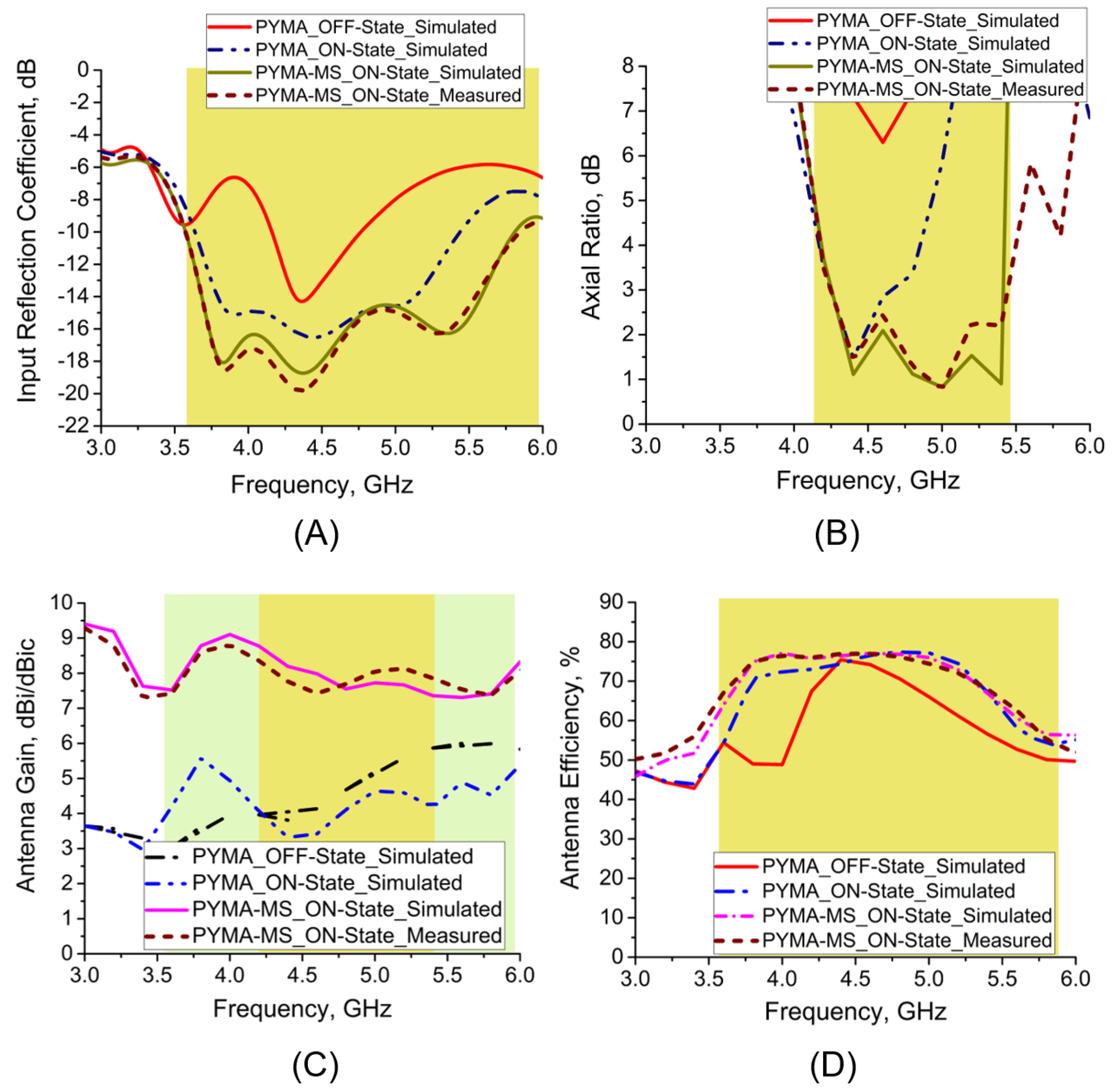
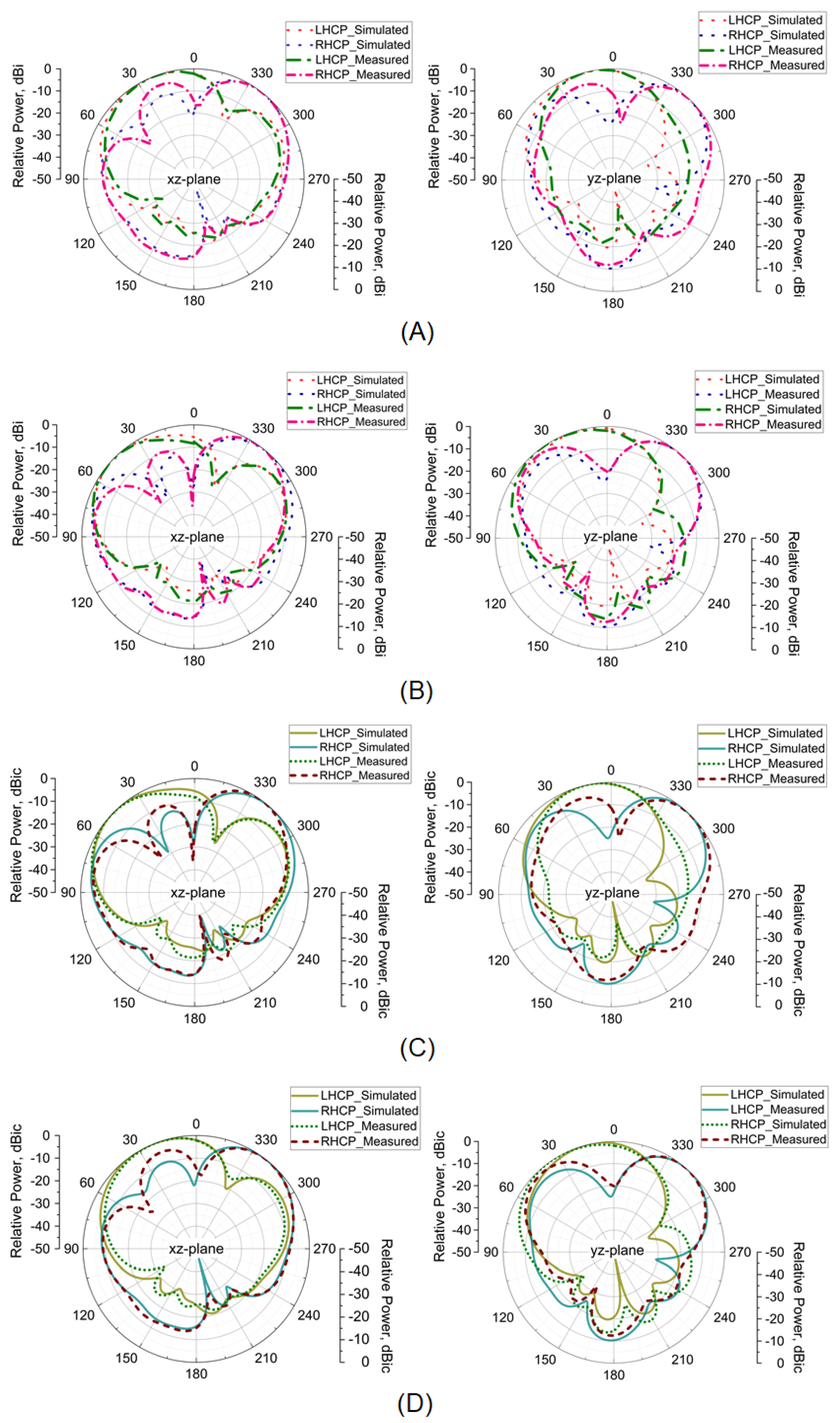
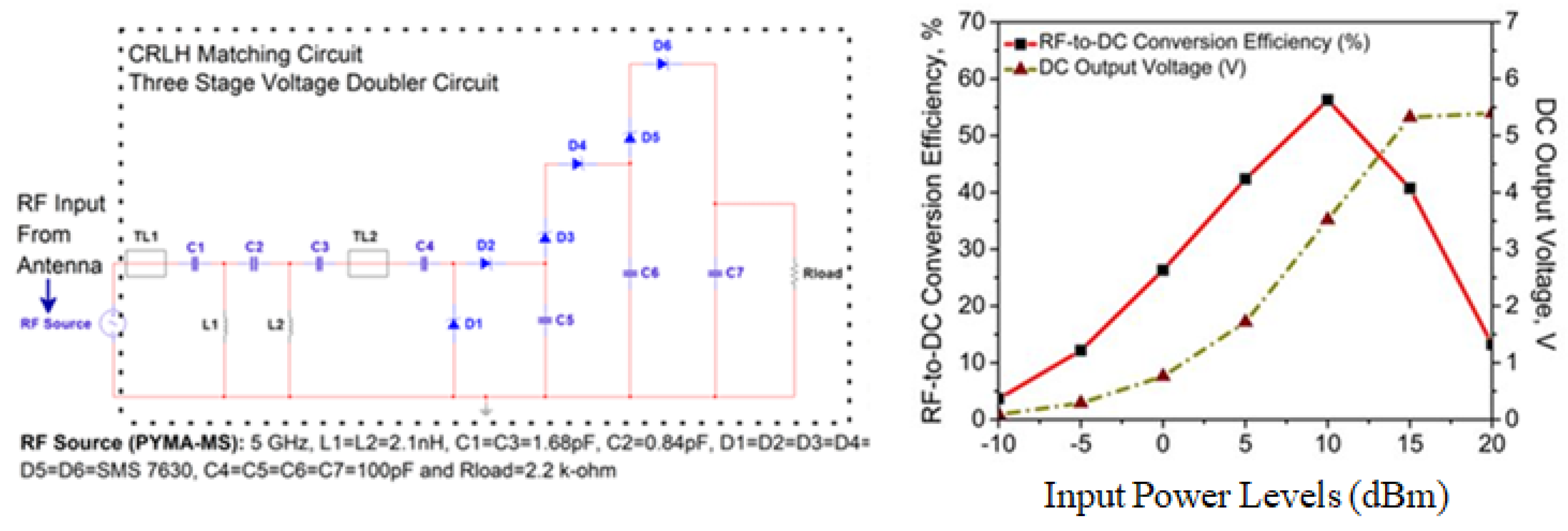
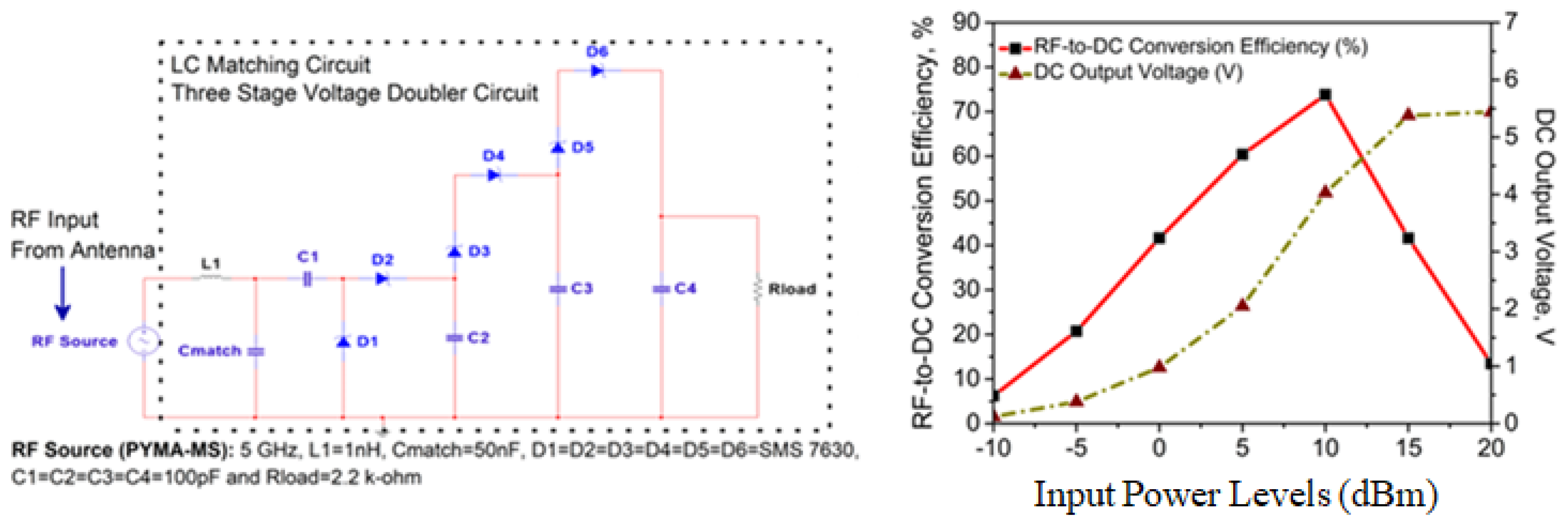
| Ref. | IBW | ARBW | CP Gain | Peak Gain | Ccriteria-1 | Ccriteria-4 |
|---|---|---|---|---|---|---|
| [10] | 7.29% | 5.5% | 6.5 dBic | 7.1 dBic | 0.35 | 0.39 |
| [11] | 28.6% | 14.2% | 4.4 dBic | 4.4 dBic | 0.62 | 0.62 |
| [12] | 31.6% | 20.8% | 6.9 dBic | 6.9 dBic | 1.43 | 1.43 |
| [13] | 35.6% | 16.3% | 5.5 dBic | 5.5 dBic | 0.89 | 0.89 |
| [14] | 29.6% | 20.7% | 7.44 dBic | 7.44 dBic | 1.54 | 1.54 |
| [15] | 12.68% | 12.68% | 6.8 dBic | 6.8 dBic | 0.86 | 0.86 |
| [16] | 20.89% | 11.4% | 5.2 dBic | 7.5 dBic | 0.59 | 0.85 |
| [17] | 19.6% | 15.8% | 4.25 dBic | 6.5 dBic | 0.67 | 1.02 |
| [18] | 33.7% | 16.5% | 5.8 dBic | 5.9 dBic | 0.95 | 0.97 |
| [19] | 17.8% | 3.6% | 7.8 dBic | 8.2 dBic | 0.28 | 0.29 |
| [20] | 27.5% | 7.8% | 6.1 dBic | 5.8 dBic | 0.47 | 0.45 |
| [21] | 20% | 20% | 6.1 dBic | 6.6 dBic | 1.22 | 1.32 |
| [22] | 8.4% | 4% | 6.1 dBic | 6.95 dBic | 0.24 | 0.27 |
| [23] | 31.8% | 20.4% | 7.47 dBic | 8.05 dBic | 1.52 | 1.64 |
| [24] | 15.1% | 12.4% | 6.15 dBic | 6.5 dBic | 0.76 | 0.81 |
| [25] | 27% | 2.5% | 3.02 dBic | 3.02 dBic | 0.07 | 0.07 |
| [26] | 1.55% | 1.05% | 7.8 dBic | 8.2 dBic | 0.07 | 0.08 |
| [27] | 25.6% | 25.6% | 7.3 dBic | 6.25 dBic | 1.6 | 1.86 |
| [28] | 23% | 14% | ——– | ——— | ——– | ——– |
| [29] | 7% | 8.3% | ——– | ——— | ——– | ——– |
| Work | 48.45% | 25.96% | 8.45 dBic | 9.15 dBic | 2.19 | 2.37 |
Disclaimer/Publisher’s Note: The statements, opinions and data contained in all publications are solely those of the individual author(s) and contributor(s) and not of MDPI and/or the editor(s). MDPI and/or the editor(s) disclaim responsibility for any injury to people or property resulting from any ideas, methods, instructions or products referred to in the content. |
© 2023 by the authors. Licensee MDPI, Basel, Switzerland. This article is an open access article distributed under the terms and conditions of the Creative Commons Attribution (CC BY) license (https://creativecommons.org/licenses/by/4.0/).
Share and Cite
Behera, B.R.; Alsharif, M.H.; Jahid, A. Investigation of a Circularly Polarized Metasurface Antenna for Hybrid Wireless Applications. Micromachines 2023, 14, 2172. https://doi.org/10.3390/mi14122172
Behera BR, Alsharif MH, Jahid A. Investigation of a Circularly Polarized Metasurface Antenna for Hybrid Wireless Applications. Micromachines. 2023; 14(12):2172. https://doi.org/10.3390/mi14122172
Chicago/Turabian StyleBehera, Bikash Ranjan, Mohammed H. Alsharif, and Abu Jahid. 2023. "Investigation of a Circularly Polarized Metasurface Antenna for Hybrid Wireless Applications" Micromachines 14, no. 12: 2172. https://doi.org/10.3390/mi14122172
APA StyleBehera, B. R., Alsharif, M. H., & Jahid, A. (2023). Investigation of a Circularly Polarized Metasurface Antenna for Hybrid Wireless Applications. Micromachines, 14(12), 2172. https://doi.org/10.3390/mi14122172








